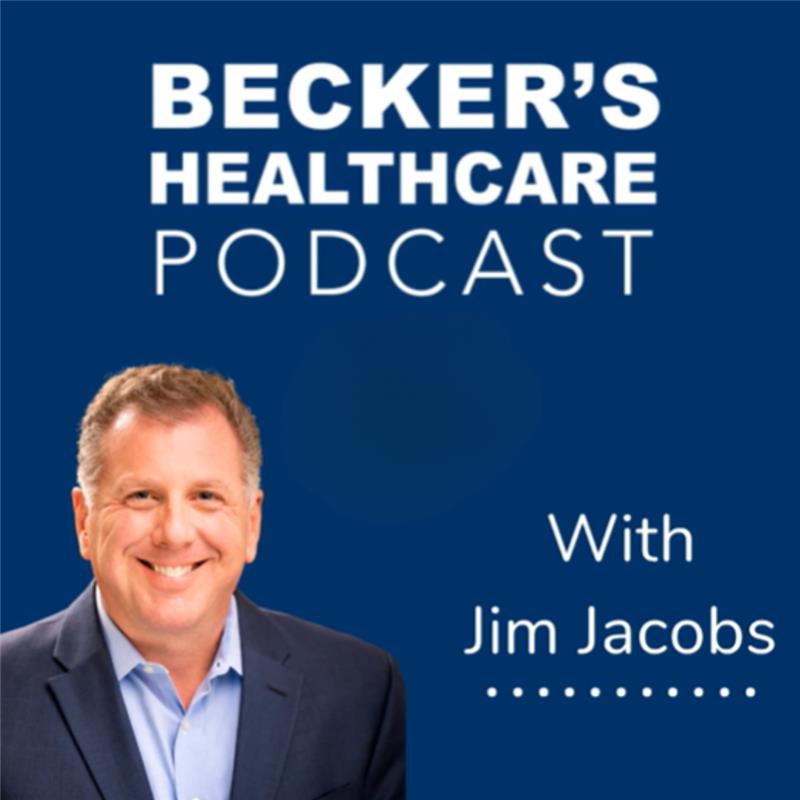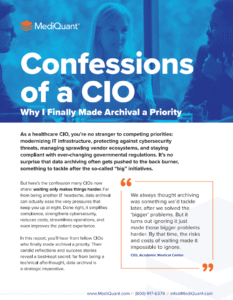Simplifying Healthcare IT Strategy & Strengthening Cybersecurity
Featuring:
Jim Jacobs, Chief Executive Officer, MediQuant
Listen to this episode of Becker’s Healthcare podcast as Jim Jacobs, President and CEO of MediQuant, discusses how healthcare organizations can streamline IT environments through application rationalization. Learn how this approach enhances cybersecurity, reduces costs, and supports smarter decision-making. Jim also shares insights on managing cultural change and adopting responsible AI strategies.

Transcript
Speaker 1 (Scott Becker): This is Scott Becker with the Becker’s Healthcare Podcast. I’m thrilled today to be joined by your brilliant leader who I love visiting with. We’re talking today with Jim Jacobs, the president and the Chief Executive Officer at Quant. We’re going to talk about IT strategy, application rationalization, cybersecurity, and a lot more about smart data management too, but a lot about how do people manage, how many applications they have going and how do they think about it and IT strategy and more. Jim, can you take a moment to tell us about yourself and quant and your career?
Speaker 2 (Jim Jacobs): Sure. And good morning. Thank you, Scott. Appreciate the introduction. I’ve been in healthcare for more than 30 years on the software side, always serving the provider market, and I’m fortunate to lead a company that’s in the active data archiving space, moving into the application rationalization space. So glad to be here.
Speaker 1 (Scott Becker): Well, thank you very, very much. And when you talk to chief executive Suite, C-Suite chief strategy, chief information officer, and more, you have this mix of issues. You’ve got people focused on risk reduction, transparency and cybersecurity, and so many different challenges, plus trying to align with the strategy of the organization. Can you talk about the importance of application rationalization and why it’s key for organizations now and into 2026 the next several years?
Speaker 2 (Jim Jacobs): Definitely. I think it’s a great insightful question. We think we’re at the beginning of very interesting changes in application rationalization because historically, the rationalization was completely manual. It was a heavy lift, took a lot of resources from the hospital systems. Then the result was a static report or spreadsheet. It was good, but it was not highly actionable. Now we’re headed towards dynamic system with risk dashboards, cost saving opportunities, and an opportunity for a remote roadmap. Specifically to your question, it’s critical, but it helps accomplish five key objectives, which is reduce cyber exposure, help with compliance risk, reduce the technology footprint, reduce cost, and it simplifies the IT responsibilities. There’s a sixth one as an added bonus for those organizations that are in acquisition mode, you can use application rationalization to help assess what you’re buying. Historically, CFOs have always known what the laundry costs were and hospitalists and all those lists, but it was very difficult to understand what you were taking on from an IT perspective. And this helps change that conversation,
Speaker 1 (Scott Becker): Particularly if you’re not managing thousands of apps. It makes it a lot easier to integrate organizations as technology and people are the key part of these mergers and integrations. And so can you talk to us a moment, Jim, about cybersecurity? I can’t go through a date without it being a serious, serious discussion. We just had our health IT and digital health conference, lots of discussion around cybersecurity and the war with ai, offense and defense. How does approaching application rationalization through a cyber securities lens support broader strategic priorities? And talk about sort of what you see organizations achieving as they work through this combined issue of application rationalization and cybersecurity.
Speaker 2 (Jim Jacobs): Yeah, it’s another great topic. You think about the number of bad actors out there and the risks we all face as healthcare providers and organizations, you have to have a cyber lens, we believe, and application rationalization is a part of a comprehensive program, and what it can do is help you create a risk continuum. So you begin to understand of the applications we have. And you’re right, some organizations have thousands of software applications. Where do we have particularly bad cyber risk? Where do we have unknown risk, where we need to go do some investigation and then try to quantify what is the risk level? Our goal is to be able to provide a risk assessment for the CIO, the ciso, however they’re organized internally. Because for example, you might have duplicate systems running. That’s an unnecessary risk. And then cyber reduction is a great justification to start consolidating systems, and we can talk more about that, but if you have systems, one of the things we’ve seen is where they’ve not been paying maintenance on the system, so trying to save money, they’ve still got the system, they’re not using it very much, but it’s still there.
Speaker 2 (Jim Jacobs): When you stop paying maintenance now you likely don’t have the latest security patches. Somebody needs to know that to get that as a priority to either start paying the maintenance and get the patches or archive the data, do something with it because somebody, the bad actors are knocking at the door, presumably you don’t want to leave a gap for them to get inside.
Speaker 1 (Scott Becker): Thank you very, very much. And following up on cybersecurity systems, try and rationalize application management, how many applications they have going. There’s always someone who feels like their S may be getting gored. And obviously if you’re in a 10,000 person organization and two people are using the application unless it’s absolutely critical to what they do, you’ve got to get rid of it for a billion different reasons. But how do you deal with the culture and the shifts as you try and deal with application rationalization and how do you work through that from a people perspective and a culture perspective?
Speaker 2 (Jim Jacobs): Yeah, I think this question is possibly the hardest issue of all. It’s one thing to say that a system is old or a system is duplicative, but to try to get the people together easily, these conversations can become emotional or personal. So internal alignment on priorities is critical. You’ve got to get the users to a place where they’ll let go of certain systems. And so how application rationalization begins to play in that is that it provides data. It begins to allow the executive teams to have better data. They can use that to prioritize. They can actually demonstrate to the stakeholders why they’re trying to consolidate systems. When you can shift the conversation to data, it becomes much more objective. It doesn’t mean that the interpersonal relations aren’t critical. There’s a Becker’s article actually out today that talks about the interpersonal relationships between executives and payers.
Speaker 2 (Jim Jacobs): I think that that article could be applied here directly because you’ve got to have people sitting together agreeing on, we’ve got a cyber risk problem and that’s worse than keeping this older system up. That’s the data that goes around it. When you talk about partnerships that coincide with that, partnerships many times can be used as an independent advisor. They’re devoid from the internal politics, they’re not involved in the issues. They can actually be somebody you can blame a third party if you want, if that’s helpful in the conversation. But I think the executives have got to prevail on this topic. They’ve got to figure out better ways to reduce cyber risk. And one way to do that is to use data to shift the conversation from an emotional one to a fact-based one.
Speaker 1 (Scott Becker): Fantastic. Kim, take a second on. You’re so focused on application rationalization and cybersecurity and helping big systems and small systems align their IT priorities and their strategies. Take a moment on sort of what you’re most excited about going forward for this coming year. We’re ending 2025. Where are you most focused and excited? Jim,
Speaker 2 (Jim Jacobs): I’m excited that the hospital systems are ever more on board with these topics that we’re talking about that the big push to get through whatever the new EHR is going to be and these massive projects, there’s people are finally lifting their heads up more and more to say, now what do we do about maximizing, optimizing, reducing risk? All the things we talked about initially. I think what’s also exciting is there’s a much more of awareness of what we call a responsible approach to ai. I hadn’t mentioned AI previously because it’s going to be a factor that’s in application rationalization, but it it’s, it’s too much a flash in the pan right now for executives to grasp. I actually think that AI itself can create a cyber risk if you’re not careful. So I think that the industry itself is reacting very appropriately. There’s a lot of great dialogues. People like you are leading the way on the conversations around how do you advise the executives on what to look for, what to look out for. They’ve got to be so cautious in the decisions they make. And so it’s an exciting time because these solutions actually offer direct value with the hard ROI help solve headaches for them. So there’s a lot to be excited about and we’re very bullish on the future.
Speaker 1 (Scott Becker): No, fantastic. And Jim, anything else we didn’t discuss today that we should be talking about and thinking about? You mentioned ai, which is the first discussion in a long time where it’s not been the focus of the discussion and starting not kicking off with that. And I appreciate that so much to get back to sort of this core of application rationalization and core IT strategy. Anything else we’ve not discussed today that you’d love to talk about for a second?
Speaker 2 (Jim Jacobs): I don’t think so. I think this covers it. I appreciate the conversation. I think that this type of conversation is, it’s an in the ground technology that can be done that CIOs can act on as opposed to too much of the distractions that are out in the market. So I like these conversations and no, I don’t think I have anything else to add to it.
Speaker 1 (Scott Becker): And I think your point is so well taken because this is something people could start working on tomorrow and see benefits on in three weeks or a month versus something that is like AI that you’re going to be doing in drips and drafts until you accelerate the improvement in where you’re going on it. So I couldn’t agree with you more. Jim Jacobs brilliant CEO of medic. I love talking to Jim. He’s wanted to be able to make the complex simple, which is one of the greatest traits in management and leadership. Jim, thank you for joining us on the Beckers Healthcare podcast today.
Speaker 2 (Jim Jacobs): Thank you so much, Scott. Have a wonderful day.
Contact Us Today
We’d love to hear from you!




